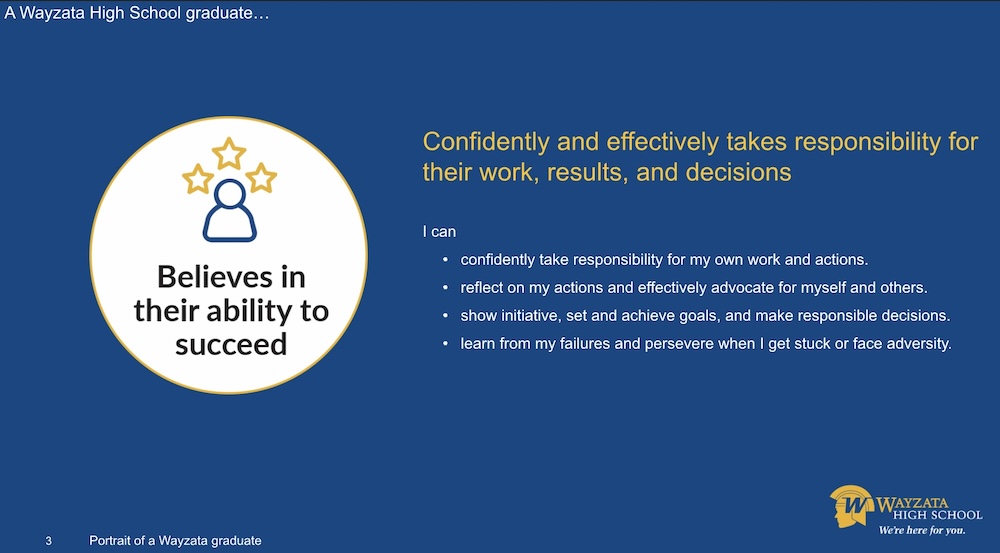Shaping Wayzata High School’s “Portrait of a Graduate” was driven, in part, by Principal Scott Gengler’s desire to make something clear to his community: Students are learning relevant skills that are preparing them for future success. With K12 “navigating a highly politicized time,” Gengler and his team of educators crafted a game plan to tie their school improvement plan and student growth goals together into a unified vision.
“There tend to be people creating their own narratives about what is and what is not happening in schools,” says Gengler, whose building is part of the Wayzata Public School District in the Minneapolis suburbs. “We try to measure the student experience the best we can by seeking not just objective educational data points, but also qualitative feedback from kids—if they’re having a high-quality experience, they’re probably going to perform.”
Wayzata’s “Portrait of a Graduate,” which launched this fall, was designed to offer students a wider perspective on what they’re learning. For example, when a parent asks a student what they learned on a particular school day, the student is likely to mention English or another subject. But if you ask the English teacher, Gengler explains, they might say something more specific, such as critical thinking.
Get on Board: How 2 superintendents reach out to school board candidates
“What we’re attempting to do through our content and experiences is show students what they’re learning is going to be significantly important to them,” he continues. “If our teachers make a concerted effort to bring meaning and relevance to what they’re doing in the classroom, then we’ve done our job.”
Portrait of a Graduate: “I can” statements
The “Portrait of a Graduate” allows educators to set clear goals for how student progress will be measured and the artifacts students can develop to demonstrate learning. Wayzata’s profile is built around “I can” statements in seven future-ready skills that stipulate “A Wayzata High graduate”:
- Believes in their ability to succeed
- Communicates effectively
- Values diversity and inclusion
- Thinks critically and creatively
- Embraces collaboration
- Demonstrates learning agility and resilience
- Focuses on personal growth
 The “diversity and inclusion” goals counsel students to act with empathy and show kindness, understand and respect people who are different from them, identify their own biases and welcome others into their community. “It forces self-assessment,” Gengler points out. “It’s constant reinforcement.”
The “diversity and inclusion” goals counsel students to act with empathy and show kindness, understand and respect people who are different from them, identify their own biases and welcome others into their community. “It forces self-assessment,” Gengler points out. “It’s constant reinforcement.”
Teachers will emphasize the portrait’s principles in small-group instruction and with students as they collaborate on projects. Dawn Johnson has spearheaded incorporating the concepts—which she calls “portrait traits” rather than 21st-century skills—in the multidisciplinary graphics communication class she co-teaches to juniors and seniors. A key part of the process is that students can focus on the skills they want to develop.
“It’s really important for rising adults to set personal goals to find relevance,” Johnson says. “I provide menus of what we’re going to do over the course of the semester, and students self-identify which learning goals are most important to them.”
Students keep journals that allow them to reflect on the traits they feel they have mastered and those they are still working on and willing to take healthy risks to develop. Students also create a LinkedIn profile to begin building their personal brand and are encouraged to use those “I can” statements as they fill in the “About Me” section.
“When we think of our school’s mission—that every student, regardless of race, class, gender and ability, will be post-secondary ready—I love the Portrait because it says how will we know,” Johnson concludes. “It gives us tangible things that we can work on with students… that if we help students with these traits, we know they’re going to be more ready for the world that’s waiting for them.”
District Administration’s Superintendent’s Playbook series examines how superintendents, principals and other administrators are solving common problems that today’s educators are facing.









